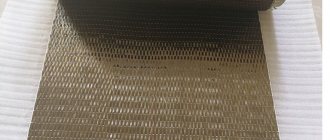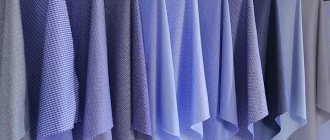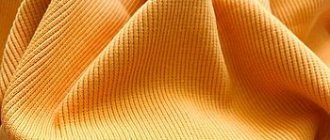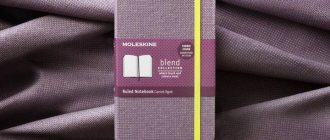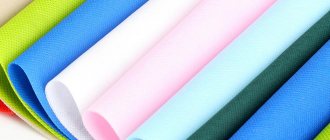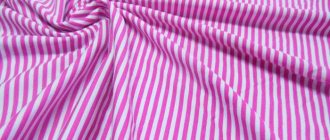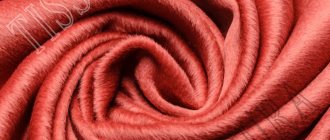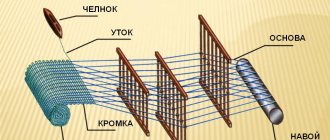Description of the fabric, its history
Real pashmina is shawls and stoles made from an elite variety of well-known cashmere. Unique material, rare and expensive. The products are very soft, not at all scratchy, pleasant to the touch. Thin, airy, and at the same time very warm. Owning them is pure pleasure. How to wear a pashmina: we have provided an example photo. We also invite you to read about the amazing features of fine linen fabric, an amazing fabric from the past.
A stole measuring 80x200 cm will weigh up to 100 g and can easily fit into a woman’s handbag. The weave of the fabric is not very dense and not always uniform, but due to the small thickness of the threads, this does not look like a flaw. Coloring - plain or with patterns. The edges of the products are raw or fringed.
The principality of Kashmir, which existed in the Himalayas many centuries ago, is considered the birthplace of pashmina. But in fact, the art of creating this finest thread was (and is) also mastered by the inhabitants of India, China and Pakistan. Each stage of creating the finest fabric required the participation of a separate craftsman (or several craftsmen): a carder, a dyer, a spinner, an artist, a weaver, and sometimes an embroiderer. Often, working with wool was the work of several generations of residents of entire villages.
Such fabric has always been very expensive, accessible only to rich people. Moreover, until the 18th century, only the rulers of the countries where it was produced could afford it. What pashmina looks like, what kind of material this is, Europe learned in the 18th century. Parisian fashionistas quickly fell prostrate in front of the weightless stoles, whose toilets, for all their sophistication, sometimes made their mistresses freeze. From then to the present, pashmina has been a status accessory that has always been in demand. Additionally, read the article “Angora fabric - photo and description of the material”, you will be interested.
Characteristics and application of fabric
Pashmina scarves can be dyed in bright colors.
Shawls, shawls and scarves are made from pashmina - the material is very valuable, expensive, produced in small quantities and therefore is not used to create hats, sweaters and mittens. The products are produced in soft cream natural shades, as well as painted in bright colors and decorated with elegant prints. Among the advantages of the material are:
- Thermal regulation – the fabric retains heat perfectly and keeps you warm;
- breathability – thanks to the weaving and structure of the fibers, the material “breathes”;
- healing effect - natural wool contains lanolin, animal wax, it has an antibacterial effect and has a positive effect on the condition of the skin;
- pashmina is very pleasant to the touch, does not prick or irritate at all, does not cause itching, and is suitable for sensitive skin;
- wear resistance - despite their delicacy, wool products last a very long time.
Flaws:
- high price;
- there is a possibility of buying a fake;
- Products should be protected from moths.
Pashmina shawls and scarves are worn in a variety of ways. The material is wrapped around the shoulders - a romantic cape can decorate a cocktail dress. Shawls are worn with jumpers and turtlenecks - just wrap the item around your neck and casually throw one end over your shoulder to get an elegant drape. Scarves are also tied on the head - massive sunglasses will help complement the look. A pashmina keeps you warm in winter, and a light woolen scarf is also suitable for cool summer nights.
Composition and manufacturing process, cost
First, let's make some clarifications regarding things defined as “pashmina”: what is “composition” in this case. The word “composition” would not be entirely appropriate here. The product itself is named according to its type (stole, shawl, scarf), and on the label, opposite the “composition” line, the word “pashmina” is indicated, used as the name of the thread. The only raw material used for its production is the down of the Himalayan mountain goat. And here lies the difference between such products and cashmere ones:
- Pashmina is 100% down, without guard hair. This is the same standard for all countries.
- Cashmere is only 40-80% fluff, the rest is wool.
We figured out what pashmina is in the composition of the fabric. Next is the method of its production. Each stage of creating an original stole is entirely handmade. It includes:
- Collecting, carding and dyeing the down of the Himalayan (mountain) goat.
- Down spinning and weaving on a handloom.
- Embroidery and fringe creation are optional.
The cost of finished accessories under such conditions is very high. Hence the high price for things whose labels contain the treasured word “pashmina”: from 15 thousand rubles for a two-meter stole. Most of what is sold in Russia is from India.
It should be noted that on sale today you can find products at a slightly lower price that have the word “pashmina” in their name, but in fact are not it. They contain only a small percentage of goat fluff, and the rest is silk at best, acrylic at worst.
Additionally, we invite you to read about the properties of a fabric called “double-thread”.
Pashmina and cashmere - what is the difference
The process of making such yarn is incredibly labor-intensive.
Both materials are made from the wool of the same animal species, but differ in quality. For the production of pashmina, only down is used, while guard hairs can be found in cashmere - 20-40% of the total amount of yarn. Cashmere is considered a coarser material and consists of thick (about 20 microns) hairs.
There are no standards for making pashmina or strict GOSTs. That is why the word pashmina refers to fabrics that are very similar to the original woolen fabric, but with the addition of cotton, silk and synthetics. When purchasing such a product, the price may be asked for the best pashmina. It is believed that it is best to buy material locally, in Nepal or India, otherwise you can simply buy cashmere and pay quite a bit.
Unfortunately, it is not easy to detect a fake, but crude analogues and substitutes can be detected by a non-specialist:
- if you run the pashmina over a delicate area of the body (neck, wrists), the material will not prick;
- machine knitted products are counterfeits and substitutes;
- When wet, pashmina does not change color at all.
With a high degree of probability, if the product has passed the test, the fabric consists exclusively of delicate down of mountain goats.
Advantages and disadvantages, scope
First, about the pleasant things, about the advantages of the material. 100% pashmina, what does it mean:
- Aesthetic value. Some products are real works of art. This can be seen in any photo requested from a search engine.
- Excellent thermal insulation qualities with low weight and without compromising breathability.
- High tactile characteristics. This fabric is pleasant to touch, it is soft, gentle and warm under your hands.
- Long service life. However, it all depends on how to store the pashmina, how to wear and care for it.
There are also disadvantages of such woolen accessories:
- High price.
- Doesn't protect against wind at all. Read about the characteristics of alova fabric and why you will never get cold in it in our other article.
- Easily damaged if not properly cared for.
- Like any wool, it is an excellent treat for moths.
Important: everything that has the right to be called “pashmina” is strictly finished products: scarves, shawls, stoles or shawls. Clothes are not made from this thread. There are no sweaters, capes or dresses made from it. If you are offered a linen sold by the meter, it is just fine wool, nothing more.
Pashmina what is it
The meaning of the word pashmina gives an idea of what kind of fabric it is. Dictionaries define the term as follows: a thin, soft, warm fabric made from the down of cashmere goats. Translated from Persian, pashmina means wool. When defining what a pashmina is, we need to add: this is also the name for scarves, stoles, and shawls made of fine wool.
Real pashmina is produced in India, Nepal or China; it cannot be brought from Tunisia or Turkey. Since goats, from whose wool yarn is obtained, live only in the Himalayas. In other countries, stoles or scarves made of fine wool or a mixture of silk and viscose are sold under this name.
Pashmina is confused with cashmere, how do they differ? The difference is in the raw materials. In the first case, only cashmere goat fluff is used, and in the second, a mixture of it with guard wool.
Product care
The first thing you should know is that pashmina material does not like washing. The ideal option is dry cleaning in a place that specializes in such fabrics. As a last resort, you can wash it, but observing the following rules:
- Water temperature no more than 25°.
- The detergent is special for wool, with lanolin, and in no case is it an ordinary powder or bleach.
- The last rinse is with a special conditioner.
- Don't twist it! We just lightly squeeze the thing in our hands. Dry naturally on a horizontal surface.
Other care features: things should be protected from exposure to hot air and direct sunlight; avoid ironing, at least - at minimum temperature and from the inside out; protect from moth damage.
Finally, a little advice: a thick terry towel will help remove water from delicate wool fabric faster. We spread it on a horizontal surface, with a stole/shawl on top. If the item does not fit along the length, fold it in half. Now roll it all up and leave it for 10 minutes. During this time, the terry cloth of the towel will draw out excess moisture from the product. Further drying - according to the recommendations above.
In order not to miss the release of other equally interesting articles, add our site to your browser bookmarks!
We also invite you to watch an informative video in which you will learn how to beautifully put on a shawl or stole:
What kind of fabric is pashmina, its properties and types
Pashmina is considered the “queen” of real woolen fabrics. In terms of quality, softness and ability to retain heat, it surpasses even cashmere (also an excellent, expensive and high-quality wool).
It is with pashmina that you can perform the famous and very effective “trick” by pulling a shawl or stole through a gold ring. However, such fabric is valued not only for its thinness.
Real pashmina is distinguished from other woolen fabrics by:
- Thermal conductivity. In cold weather it warms perfectly, and in hot weather it is not hot.
- Extreme softness. By applying the product to the skin on the neck or forearm, it is impossible to feel even the slightest tingling or discomfort.
- Plastic. There are practically no scars or creases on the fabric, it falls gently and drapes easily.
- Antibacterial effect and hypoallergenic. Lanolin contained in wool has healing properties.
- Long lasting wear. With proper and careful care, a pashmina product will last for many years.
Pashmina items are suitable for any style and for any age.
Fabric reviews
Lyudmila “Oh, this is a super thing, I love it impossible. They gave me a pashmina scarf; I would never have decided to make such a purchase myself. Indeed, very soft, tender, and warm in it. And there are no words for how beautiful it looks. In general, I have nothing but praises.”
Ekaterina “For a long time I walked and dreamed of a pashmina, fought with that toad that did not allow me to fork out for a stole. In the end I bought it and did not regret it. True, I spent several days choosing, there were so many interesting colors, I didn’t know which one to choose, so that I wouldn’t regret later that I didn’t choose this one or that one. It’s a beautiful thing, warm, warm, although thin, almost translucent.”
How to distinguish from a fake
It is difficult to distinguish a pashmina from a high-quality fake, but there are several ways to identify a crude imitation:
- hand-made textiles are always heterogeneous, machine knitting is dense, the threads fit tightly to each other;
- run the scarf or stole over your wrist or neck - you should feel softness and tenderness. Tingling or hardness means that the raw material contains guard hairs and is not 100% pashmina;
- wet the edge of the product, it should not change color after that;
- Too bright color of the product should alert you. Goat down does not absorb dye well, making it very difficult to obtain a rich shade.
In India, only one company (Kashmiri Pashmina) received a patent with the right to produce stoles from this material.
Method of obtaining pashmina
Pashmina is a special woolen fabric that is made only in one region of India - Kashmir. It is there that live the animals that provide the raw materials for this finest wool fabric - stone goats. Their usual habitat is high mountain slopes, which are blown by harsh winds from all sides. This is what causes the growth of soft and, at the same time, very warm undercoat, which they shed in the summer (due to uselessness). The shepherds wait until the spring warms up to comb out this very undercoat, after which they select suitable threads and weave warm shawls by hand. The shawls are very warm and thin because the thickest threads of the undercoat are about five times thinner than human hair. Thanks to this property, you can easily check which pashmina was used to make your shawl. If you bought a real Kashmiri shawl, you can easily thread it through a woman's ring.
Story
These shawls have been made in Nepal and Tibet for a very long time: 3000 years ago, our ancestors sported pashminas, which, of course, were somewhat different from modern samples.
Pashmina is wool, known since time immemorial in the Middle East and Asia - maharajas, sultans and emperors bought the best shawls and capes for their court, which served for ceremonial vestments, and were also passed down by inheritance (this material, with proper care, can serve very well). for a long time). This piece of clothing has transformed from a shepherd's garment into a royal one.
As usual, the French introduced this material into fashion in Europe: Napoleon Bonaparte received a huge number of gifts during his campaign against Egypt, among which was the warmest and finest pashmina wool stole. He sent it to Josephine Beauharnais (his wife), who was delighted with it. Later she began to collect a collection of pashminas, eventually their number exceeded 1000 pieces. Manufacturers were sent instructions regarding the design and color of shawls and stoles so that they would correspond to current fashion.
Buying Pashmina
Large stores and well-known brands are interested in maintaining their reputation. They cannot afford to sell fakes, so it is best to buy pashmina wool from them. Cashmere in general is also better to buy there. Be careful with unknown small shops. If you suddenly decide to purchase such an item from one of them, ask the seller where the material was made, and also ask them to explain the difference between pashmina and cashmere. If the seller, in response to the first question, names any country other than Mongolia, Nepal or India, most likely this is a counterfeit product.
